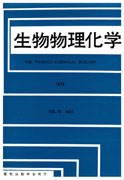All issues

Successor
Volume 18 (1973 - 197・・・
- Issue 4 Pages 233-
- Issue 3 Pages 159-
- Issue 2 Pages 79-
- Issue 1 Pages 1-
Volume 18, Issue 4
Displaying 1-4 of 4 articles from this issue
- |<
- <
- 1
- >
- >|
-
A Family of Fast Type Alloalbuminemia (Albumin Kyoto)Junzo Nishiyama, Hiroshi Andachi, Kazuo Nakanishi, Yoshio Nakanishi, T ...1974Volume 18Issue 4 Pages 233-239
Published: July 25, 1974
Released on J-STAGE: March 31, 2009
JOURNAL FREE ACCESSIn a family of the fast type alloalbuminemia, 13 heterozygous cases were found through 3 generations, showing the autosomal codominant inheritance. The presence of the variant albumin was not directly associated with any disease. Binding studies seem to indicate that Albf has greater ability to bind BPB dye and thyroxine, when small amounts of those were added. No immunological difference between Albf and Albn was observed.View full abstractDownload PDF (4913K) -
Nobuya Hashimoto, Keiji Suzuki, Hiroaki Maeno, Hirohisa Tanaka, Katsuh ...1974Volume 18Issue 4 Pages 241-260
Published: July 25, 1974
Released on J-STAGE: March 31, 2009
JOURNAL FREE ACCESSCell electrophoresis is a useful method to measure electric charge on cell membrane and recognize precisely biological changes on the surface of cells. In the present paper, cell electrophoresis was used in an attempt to investigate various changes on the surface of human lymphocytes, which were separated from human peripheral blood by means of 3% gelatin sedimentation method, with the following results.
1. Cell electrophoretic mobility was 0.983±0.189μ/sec/V/cm in average of eighty one normal subjects. Human lymphocytes were shown to be heterogeneous electrophoretically.
2. Cell electrophoretic mobility of the human lymphocytes from patients with lymph tissue disorders was investigated. Electrophoresis of four cases of acute myelogenous leukemia (AML) did not show significant change in both electrophoretic mobility and cytopherogram. A case of AML in which 70% of cells in peripheral blood were leukemic, however, showed a cytopherographically homogeneous pattern. The lymphocytes from giant follicular lymphoma and reticulosarcoma did not show marked changes.
3. Cell electropheretic mobility of the lymphocytes treated with anti-human lymphocyte antibody (ALS) was investigated. Cytotoxic antibodies were obtained from the pregnant female sera as judged by the micro-droplet lymphocyte cytotoxicity test. Electrophoresis was carried out after the lymphocytes were incubated with ALS. Electrophoretic mobility of the lymphocyte treated with high titer ALS was lower than that treated with low titer ALS. It was shown that lowering of electrophoretic mobility was correlated with cytotoxic activity of ALS.
4. Cell electrophoretic mobility of the lymphocytes sensitized with the anti-homologous γ-globulin and various anti-immunoglobulin polypeptide chains was investigated.
Electrophoretic mobility of the lymphocytes treated with anti-human γ-globulin was lower. The phenomenon was significantly found in the lymphocytes treated with anti-μ, anti-κ, and anti-λ polypeptide chain sera, but not so markedly in those treated with anti-γ or anti-α chain sera. However, electrophoresis of the lymphocytes treated with anti-γ and anti-α sera showed that the delay phenomenon of mobility occurred on some of the cells. From the results of the experiments, it was suggested that large amounts of μ-chain, κ-chain and λ-chain and small amounts of γ-chain and α-chain are present on the surface of human lymphocytes.
The results were discussed with comprehensive survey of literatures on cell electrophoretic investigations of human lymphocytes.View full abstractDownload PDF (6219K) -
Seiju Onodera, Chuichi Itoh, Yukio Imamura1974Volume 18Issue 4 Pages 261-264
Published: July 25, 1974
Released on J-STAGE: March 31, 2009
JOURNAL FREE ACCESSDownload PDF (7131K) -
Yoshihiko Takada, Isao Ono, Tadashi Kawai1974Volume 18Issue 4 Pages 265-267
Published: July 25, 1974
Released on J-STAGE: March 31, 2009
JOURNAL FREE ACCESSDownload PDF (3533K)
- |<
- <
- 1
- >
- >|